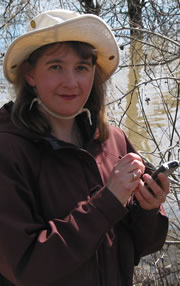Getting down at the Yellow Quill Prairie
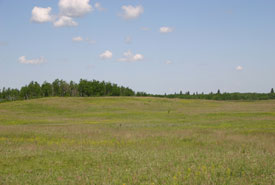
The Yellow Quill Prairie Preserve on a sunny day (Photo by Diana Bizecki Robson)
Last week I started my field season by getting down on my hands and knees to collect plants and pollinators at the Yellow Quill Prairie Preserve south of Brandon, which is owned and managed by the Nature Conservancy of Canada. While that may not sound particularly appealing to you, it is something that I love about my job. After a long winter stuck inside, it is marvelous to spend some time out in nature appreciating the absence of city noise.
When I arrived at the prairie, I was greeted by a sound that I absolutely adore: the call of a western meadowlark. Nothing says “prairie” like a meadowlark!
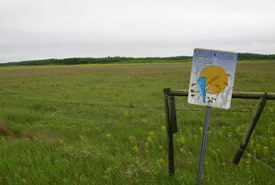
It was cool and rainy when I got to the NCC's Yellow Quill Prairie Preserve (Photo by Diana Bizecki Robson)
Unfortunately I was also greeted by something not so pleasant: rain and wind. Those two things in combination result in the dreaded sideways rain; you know, the rain that hits you right in the face rather than landing on your hat. “Oh well,” I thought, “all I have to do on the first day is select my plots and I can do that in a bit of rain.”
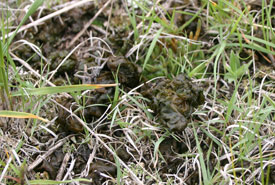
Star jellies puff up and turn green when it rains (Photo by Diana Bizecki Robson)
A little rain actually makes an interesting little prairie organism come to life: star jelly. This organism looks like a tiny piece of crispy black poop when it’s dry but a greenish, gelatinous blob when wet. It’s actually a colonial cyanobacteria that lives on the prairies and adds much-needed nitrogen to the soil. I also saw a well-disguised grasshopper blending in with the lichens and star jellies.
The next day was my first day of pollinator surveys and though it wasn’t raining, it was so cool and windy that I saw virtually no insects. Luck was with me the next day, though, as I encountered perfect pollinator weather: it was warm, sunny and only a gentle breeze was blowing. Plus there were no ticks or mosquitoes! That rarely happens in Manitoba and was nice break from the last few years, when I was constantly picking ticks off my pants.
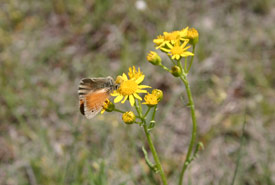
Yellow crab spiders blend in with the groundsel flowers, making it easier for them to catch and eat pollinators like this butterfly (Photo by Diana Bizecki Robson)
In addition to some nice big bumblebees, sweat bees and a really cool beefly, there were several butterflies buzzing about as well. One of them was not so lucky, as it got captured by a crab spider hiding on a groundsel flower; a sad ending to a beautiful creature, but spiders need to live too!
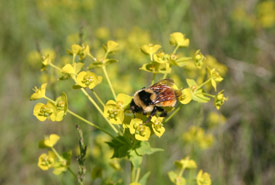
Bumblebees were visiting the invasive leafy spurge plants at the preserve (Photo by Diana Bizecki Robson)
When I first started working at the museum 12 years ago, I decided to study plant-pollinator relationships in tall grass prairie because it was an ecosystem that I had not visited before. Two years ago I switched to fescue prairie and now, to complete my understanding of prairie pollination, I need some data on mixed grass prairie as well. My research will help us better understand how these prairies differ from each other and which plant species are most important for prairie pollinators.
I will be visiting the Yellow Quill Prairie every two weeks until mid-September and will keep you updated on the wonderful things that I see throughout the summer.
This research is made possible by funding from the Nature Conservancy of Canada and the Manitoba Museum Foundation.

